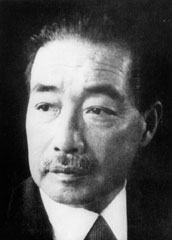- Hakushū Kitahara
Infobox Writer
name = Hakushū Kitahara

caption = Hakushū Kitahara
birthdate = birth date|1885|1|25|df=y
birthplace =Yanagawa, Fukuoka ,Japan
deathdate = death date and age|1942|11|2|1885|1|25|df=y
deathplace = Kamakura,Japan
occupation = Poet
genre = poetry
movement =Pan no kai
notableworks = Jashumon (Heretics, 1909)
influences =Tōson Shimazaki
influenced =nihongo|Hakushū Kitahara|北原 白秋|Kitahara Hakushū|extra=
25 January 1885 –2 November ,1942 is thepen-name of a "tanka"poet in Taishō andShowa period Japan . His real name is nihongo|Kitahara Ryūkichi|北原 隆吉|Kitahara Ryūkichi. He is regarded as one of the most popular and important poets in modernJapanese literature .Early life
Kitahara was born in Yanagawa,
Fukuoka prefecture , to a family of "sake " brewers. He attended theEnglish literature department ofWaseda University , but he left the university soon after without graduating. As a student he became interested in the poetry ofToson Shimazaki , especially his "Wakanashu" (Collection of Young Herbs, 1897), which was written in the "Shintaishi", or New Style, format.Literary career
In 1904, Kitahara moved to
Tokyo and began submitting his poetry to variousliterary magazine s. In 1906, he joined the "Shinshisha" (New Poetry Association) at the invitation ofYosano Tekkan , and he published poems in its magazineMyōjō (Bright Star) that brought him instant fame as a rising young poet, and served as an introduction to a wide circle of writers and poets. From these contacts, Kitahara formed his own literary group, the "Pan no kai " (The Society ofPan ), which was innovative in including painters, musicians and actors as well as writers.In 1909, he became one of the founding members of the literary magazine, "Subaru" (The Pleiades), where he published his first collection of verses, "Jashumon" (Heretics), which took the poetic world by storm. Through the use of its rich imagery and innovative structure, it (along with
Yosano Akiko 's "Midaregami"), is credited by critics with having set a new baseline for modern Japanese poetry. Kitahara's initial success was followed by "Omoide" (Memories, 1912), in which he evokes memories of the world from a child's perspective.In 1912, Kitahara was arrested for
adultery and jailed for two weeks. Though the charges were later dropped, the experience was traumatic, as it was mentioned briefly in his first "tanka" anthology, "Kiri no hana" (Paulownia Blossoms, 1913), as having led to a religious influence in his outlook on life. This became evident in his second anthology, "Shinju Sho" (Selection of Pearls, 1914), and his third, "Hakkin no koma" (Platinum Top, 1915), which include one-line poems in the form ofBuddhist prayers. He strove for what he called “oriental simplicity”, a concept which he borrowed from his understanding ofZen in "Suibokushu" (Collection of Ink drawings, 1923) and "Suzume no tamago" (Sparrow's Eggs, 1921).Children's poems
In 1918, he joined the "Akai Tori" (Red Bird) literary magazine at the request of founder
Suzuki Miekichi , and was assigned to create children's songs, take charge of screening the poems submitted to the magazine, and collectnursery rhymes from around the country. The same year, he relocated from Tokyo toOdawara, Kanagawa . In 1919 he published "Tonbo no medama" (Dragonfly's Eyes), a collection of lyrics for children he had previously published serially in Akai Tori. In 1921 "Maza gusu" (Mother Goose ), a collection of his translations of the English classic, came out, and that year, "Usagi no denpo" (Rabbit Telegrams), a collection of his nursery rhymes, was published. Starting with its April 1922 issue, "Kodomo no kuni" (Children's Land), it invited readers to submit children's songs, and Kitahara took charge of the screening and comments. In 1929 he published a collection of essays on children's songs, "Midori no shokkaku" (The Feel of Green).Later life
Always enjoying travel, Kitahara visited Misaki, Chiba, Nagano, Shiobara in 1923, Shizuoka in 1924,
Hokkaidō andKarafuto in 1925.Kitahara moved back to Tokyo in 1926, living at first in Yanaka, then moving to Setagaya in 1928. Kitahara continued to experiment with his style, and continued to be inspired by classical Japanese literature (such as the "
Kojiki "), as seen in his "Kaihyo no kumo" (Sea and Clouds, 1929). This later work was inspired by a trip from Oita to Osaka byairplane , which was sponsored by theAsahi Shimbun as a publicity stunt. In 1930, Kitahara travelled toManchuria , and rode on theSouth Manchurian Railroad . On his return to Japan, he visited Nara.In 1935, Kitahara founded "Tama", a "tanka" magazine, and became known as the spearhead of the fourth stage of the symbolist movement. Among his protégés were
Kimata Osamu andMiya Shuji . He also accepted an invitation by theOsaka Mainichi Shimbun to tourKorea (then under Japanese rule), in exchange for poems on his impressions. Kitahara remained active even after almost going blind due to complications arising fromdiabetes in 1937. In 1940, he returned for a visit to Yanagawa after many years, and also visitedMiyazaki and Nara. That same year he was made a member of theJapan Art Academy . In 1942, his health condition worsened, and he died of complications from his diabetes. His grave is located at the Tama Reien in the outskirts of Tokyo.Legacy
Kitahara published a total of over 200 books within his lifetime. In addition to his writings, he also edited the poetry magazine "Chijo junrei" (Earthly Pilgrimage), which enabled later authors, such as
Hagiwara Sakutaro to get their start into the literary world. He also wrote anthems for high schools around the country, includingTōyō Eiwa Jogakuin . Many of his poems remain popular to this day. The "Nihon Densho Doyo Shusei" [Collection of Traditional Japanese Nursery Rhymes] , a six-volume publication edited by Kitahara, finally came out in 1976.ee also
*
Japanese literature
*List of Japanese authors References
* Fukasawa, Margaret Benton. "Kitahara Hakushu: His Life and Poetry". East Asia Program Cornell University (1993). ISBN-10: 0939657651
External links
* [http://www.aozora.gr.jp/index_pages/person106.html#sakuhin_list_1 e-texts of Hakushu's works] at
Aozora bunko
* [http://www.city.kamakura.kanagawa.jp/bunka/bunjinroku/hakushuu_e.htm Kamakura’s Literary Figures]
* [http://www.hakushu.or.jp/ Hakushu Memorial Museum, Yanagawa, Fukuoka (Japanese site)]
* [http://members2.jcom.home.ne.jp/kitahara-hakushu/ Hakushu Memorial Museum, Miura, Yokosuka (Japanese site)]
Wikimedia Foundation. 2010.
